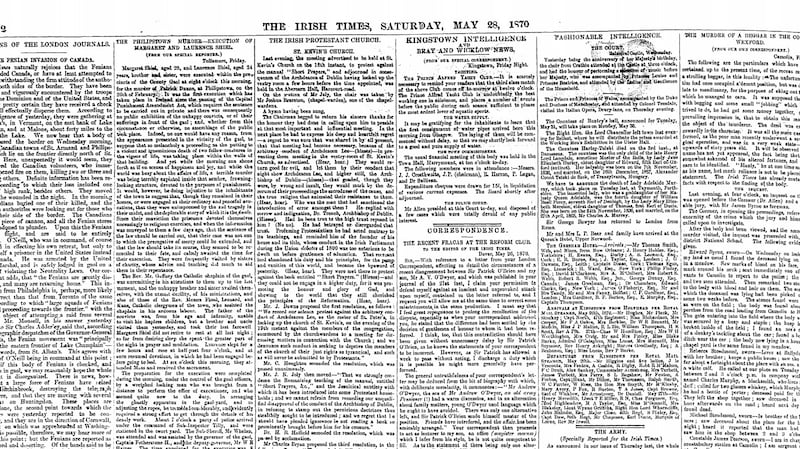Patrick Dunne lived with his mother in a cabin just outside Philipstown in King's County – now Daingean, and now Co Offaly. The normal route home for the farm servant, who was about 30 when he was shot dead, took him past a gate, near a stile, over which a walker would find a path that provided a shortcut to the home of Pat Sheil – an old man. Ellis's gate, as it was known, stood about 265m – or 53 perches – south of the town.
It was on the side of the road near Ellis’s gate where a man named Thomas Russell found Dunne on the evening of February 26th, 1870. It was about 8pm, the night was dark, Dunne had his feet in the drain and he was drenched from head to toe. At that point, his mother would have expected him home.
“I asked him what ailed him,” recalled Russell, according to official records.
“Is that Tom?” asked Dunne.
“Yes,” said Russell.
“I am dying,” replied Dunne.
“He seemed to be perfectly in possession of his senses,” Russell later said. A cart was summoned and the injured man was taken to the dispensary, where he was attended by a doctor, a priest and a magistrate.
Dunne could describe with clarity what happened to him. The injured man told Russell he had been shot, and that he knew who pulled the trigger. But the damning statement he made a short time later on his deathbed was very nearly thrown out when the case came to trial at the Assizes the following spring.
*****
The story of Dunne’s murder begins many months beforehand. The above-mentioned old man, Pat Sheil, lived with his children Peter, Laurence (Larry) and Margaret (Peggy). The Sheils and Dunne, in short, did not get along.
Throughout reports and records concerning “The Philipstown Murder”, mentions are made of a feud over the right of way to a small area of bog. Records from the Petty Sessions in 1868 shed a little more light.
Peter was brought before a judge a number of times that year for preventing people accessing Toberronan bog. The first complaint, by a man named Bernard Tracy, alleged that Peter “unlawfully” prevented him drawing his turf on May 30th, 1868 – with the defendant “having no legal claim on said turf”. Peter was let off, on that occasion.
In August, it was a similar story – but this time the complainant was Patrick Dunne. The farm servant alleged he was prevented “by threats” from drawing his turf at the same bog.
In October, Peter escalated his campaign, and Dunne became the target. The complaint in the court record reads: “Defendant did assault Complainant at Toberronan on the 12th October 1868 by inflicting . . . wounds on his head with a blow of a shovel.” This time, Peter was jailed for six months.
That stoked the fire. It would be Larry and Peggy who exacted revenge. At least, that’s what Patrick told Russell when he found him wet and freezing at the roadside, and what he repeated to the resident magistrate, Mr Scully, later that evening.
His official declaration was as follows: “I, Patrick Dunne, of Togher, Philipstown, do believe myself to be dying, and do declare that Peggy Sheil and Larry Sheil were standing on the road at Togher, and I on my way home this Saturday evening; they bid me good night, when Peggy Sheil fired a pistol shot at me; I turned round, when she again fired another shot at me; they both then went into Mr Ellis’s field; I was afraid of them since the burning of the turf.”

The young man signed the above statement with an “X”. Thirty minutes later, he began having severe paroxysms of pain and begged to be put out of his misery. An hour after that, he died. Dunne had been shot twice – the first skimmed the top of his head, the second had been fired into his back, breaking his shoulder blade.
*****
Police arrested Peggy at her father’s house, according to one report. About the same time, they picked up Larry, who was trying to board an emigrant ship to America at Cobh – then Queenstown – under the name Byrne. A pistol belonging to Larry was recovered, along with scraps of the wadding required to fire the shots.
At trial, the pair’s father presented an alibi, which didn’t hold up. Quickly, Peggy was painted as the orchestrator, with evidence to suggest she had the murder planned for some time. A man named Thomas Rooney swore that Peggy said she would pay £10 for a man to kill Dunne, and when Rooney suggested she see a priest, Peggy had replied: “To hell with the priests” and said she would “hold a basin for the priest’s heart, to see a man cutting Dunne’s throat”.
The pair were found guilty on April 1st and sentenced to death.
The dead man’s statement was key to securing the conviction, and was submitted as a “dying declaration” – which holds more weight in court; why would a dying person lie?
To qualify as a dying declaration, it had to be shown that Dunne knew he was dying. The matter was challenged by the defence, and went as far as the Court of Criminal Appeal. It’s for that reason that files about the crime in the National Archives detail Dunne’s dying moments in great detail.
Scully, the magistrate, stood at Dunne’s head after last rites had been given, and as per the procedure for taking a dying declaration, Scully asked if Dunne knew who he, the magistrate, was. The dying man said he did. Scully then asked: “Do you believe you are dying?”
Dunne replied: “I do.” Scully then took the testimony. A short while later, as his condition worsened, Dunne complicated the matter by asking: “Am I dying?”
The question “Am I dying?” was where the defence staged their bid to have the evidence thrown out. Was it a genuine question? Why would he ask that question if he believed he was dying? Did it nullify the sanctity of the dying declaration? The priest, doctor and magistrate thought not.
Perhaps it was a general exclamation – or if interpreted verbatim, perhaps he was asking if he was just then in the act of dying. In the end, the appeal failed, and the conviction was upheld.
*****
The jury recommended mercy for the prisoners. A memorial was signed in a bid to spare their lives – the killing, the petition argued, was the result of a family dispute, rather than an agrarian crime; the latter would have been seen as a more serious affair in those decades.
The family had seen too much suffering, they argued; another brother had been murdered some years beforehand. Laurence, they said, was a young man and easily influenced, while Margaret was “a person of very excitable disposition”.
The sun was shining on the morning Peggy and Larry were hanged. We know that because The Irish Times reporter mentioned the weather. Contemporaneous reports of Victorian-era hangings leaned towards the dramatic, to put it mildly. This one was no different. The gaol building at Tullamore where the action was to take place “frowned”, yet the sun beamed “as if on scenes of happiness and joy”.
The reportage was familiar, but this was no ordinary execution story. That day, May 27th 1870 – 150 years ago this week – would mark the first execution in Ireland following the Capital Punishment Amendment Act, 1868, which outlawed public hangings. The public were barred, but reporters were allowed to attend.
*****
The late 19th century saw a growing appetite for the abolition of capital punishment, a trend which can be seen in the hanging procedure itself. As hangings retreated behind prison walls, the need for a platform disappeared. Instead, pits were dug, into which a body could fall and remain for a time before being cut down and buried.
The length of the rope , or “drop”, became important, too; as the century wore on, weight-to-rope-length ratios would be devised –– most notably by William Marwood and later James Berry – to better ensure quick, struggle-free deaths.
In 1870, they still had some way to go. The London executioner at the time, William Calcraft, had a reputation as a bit of a brute, and morbid stories of his notoriously short drops are plentiful in newspaper archives. However, it does not appear that Calcraft travelled to Ireland 150 years ago for this particular job. Though a hangman was kept on government retainer, technically it was a sort of freelance gig: anyone could apply. Sailors were sometimes chosen because they tied the best knots, and an English executioner passing up a trip to Ireland in those decades was not rare.
In the case of the Sheils’ execution, the hangman is unnamed. Preparations were made by “a wretched looking man who was brought from a distance to perform the office of executioner, and who seemed quite new to the duty,” we’re told. The hangman “trembled considerably” while setting up the ropes.
The prisoners never confessed, but apparently acknowledged the justice of the sentence. Following the trial, they took to praying. Many did. Execution reports often cited the careful religious observations made by condemned prisoners once the chance of reprieve disappeared. Pat Sheil was too weak to visit his children, though their brother did make the trip.
On the morning of the execution, Larry was “white as a sheet”, while Peggy wore black silk, and stood onto the scaffold first. When she ascended, she turned and beckoned her brother to follow. The reporter noted her “firmness and composure”, echoing a court report from the previous month: when the pair were sentenced to death, Peggy was “the only unmoved person” in the room.
“The executioner adjusted the ropes round their necks, and, on a given signal, the bolt was drawn, and both fell struggling in the agony of death.”
The bell tolled at 8am and a black flag was hoisted to signal the fulfilment of the sentence. Peggy was 29 when she died, and Larry 25. Their bodies were buried in a corner of the prison yard.




















